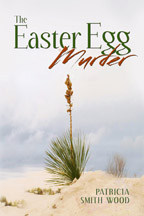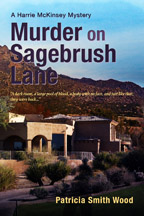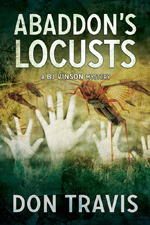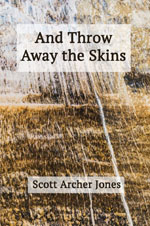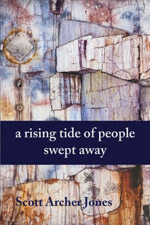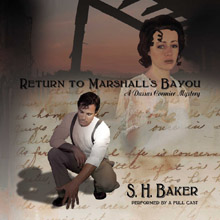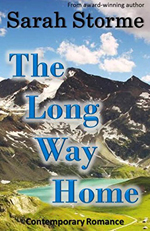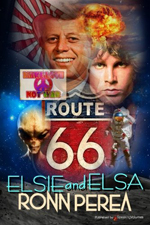Don Morgan is a versatile author of 13 published novels written in different genres under the separate names of Donald T. Morgan, Don Travis, and Mark Wildyr. As Don Travis, he’s released four mysteries through Dreamspinner Press, with a fifth scheduled for publication in 2019. His newest book, The Lovely Pines (August 2018), is the fourth volume in his BJ Vinson Mystery series that follows a private investigator and his partner as they solve crimes across the Land of Enchantment. You’ll find Don on his website at DonTravis.com and on Facebook and Twitter.
 What is your elevator pitch for The Lovely Pines?
What is your elevator pitch for The Lovely Pines?
When Ariel Gonda’s winery, The Lovely Pines, suffers a break-in, the police write the incident off as a prank since nothing was taken. But Ariel knows something is wrong—small clues are beginning to add up—and he turns to private investigator BJ Vinson for help. When a vineyard worker is killed, there are plenty of suspects to go around. But are the two crimes related? As BJ and his significant other, Paul Barton, follow the trail from the central New Mexico wine country south to Las Cruces and Carlsbad, they discover a tangled web involving members of the US military, a mistaken identity, a family fortune in dispute, and even a secret baby. The body count is rising, and a child may be in danger. BJ will need all his skills to survive, because between a deadly sniper and sabotage, someone is determined to make sure this case goes unsolved.
What unique challenges did this work pose for you?
I know nothing about the wine industry. Heck, I don’t even drink it, except for an occasional glass of red with a good bleu cheese salad, but wine making needed to be at the center of the novel. Why? Because my books feature New Mexico as a continuing character. Each book showcases a different part of this beautiful state. And because I wanted a pivotal character to be Ariel Gonda, the book had to revolve around wine. Why Ariel Gonda? Simple, I liked his name when he showed up (by reference only) as the treasurer of the Alfano Vineyards in The Bisti Business, the second book in the series. Simple-minded, I know, but there you are. I also wanted to concentrate on the Albuquerque/Bernalillo/Placitas area of the state, and that’s wine country. Ergo… I’m trapped into writing about wine. Ariel and his wife and nephew are Swiss nationals, which lent a bit of uncertainty between the European concept of primogeniture and our own hereditary laws and customs.
How did the book come together?
As I said above, the novel came out of a desire to develop the character of the Swiss winemaker and to roam around the area north of Albuquerque east to the Sandia foothills. I began the book on April 13, 2016 and completed the first draft in March of 2017. I did two additional drafts, finishing the last on April 17, 2017. (Successive drafts tend to go fast). I am able to quote specific dates because I note successive drafts with a beginning and a completion date. I will often do as many as five or six drafts, but this book didn’t take that many.
My editing style is right out of the public school English Grammar classes of the last century, full of commas, too many exclamation points, and the like. By the time my publisher, Dreamspinner Press (DSP), completes their three edits (and I really appreciate the fact they go to this extreme), it’s more or less Chicago Manual of Style (CMOS) mixed with DSP house style. Because my head editor knows how much I despise CMOS, they diplomatically claim the changes they want are to conform with house style. Not surprisingly, they win a few editing points, and I win a few. That’s the way it should be, right?
Tell us about your characters.
The protagonist of all the books in this series is Burleigh J. Vinson. (Do you blame him for going by BJ?) He is a former Marine, ex-Albuquerque Police detective turned confidential investigator (he doesn’t like the label private investigator) who is gay but moves comfortably through every strata of Albuquerque society. He neither flaunts his homosexuality nor conceals it. He would probably prefer to still be an Albuquerque cop, but a bullet wound put an end to that career. Paul Barton is a UNM grad student majoring in journalism. He intends to become an investigative journalist, which is likely one thing that draws him to the intrepid investigator BJ Vinson. They meet in the first book, The Zozobra Incident, where BJ has difficulty in determining if Paul is one of the good guys or one of the bad guys. Either way, they establish a powerful connection which grows into love.
Lt. Eugene Enriquez is BJ’s former riding partner when they were both APD detectives. They remain close, helping one another with problems. Ariel and Margot Gonda are the owners of The Lovely Pines Winery and Vineyard in fictional Villa Plácido, New Mexico. Charlie and Hazel Weeks are BJ’s business partners. Charlie is a retired cop, and Hazel is the office manager of Vinson and Weeks Confidential Investigations. The antagonist in the story is not revealed until the final pages of the book, so I’ll not mention that individual here. The remainder of the characters are drawn from the winery workers, former owners of the Lovely Pines, two AWOL soldiers, and other fringe players.
In listing major players, I would have to include the Land of Enchantment, the 47th state of the United States. New Mexico—the fifth largest and fifth least populated of the states with a landmass of 121,699 square miles and a population of around 2,000,000—is one of the Mountain States located in the southwestern section of the nation. A “wowser” of a state!
Why did you choose New Mexico as the setting for the series?
Is it not apparent that I am in love with this country? I was born in woodland Oklahoma, attended college in Texas, settled in fabled Denver after service in the army, but was bowled over when I drove south into the Land of Enchantment. I had found a home.
Did you discover anything surprising or interesting when doing research for the book?
I always learn something that surprises me, and a lot that interests me, when I begin research for a book. I learned Bernalillo was originally an Anasazi settlement a thousand or so years before the Spanish settled the abandoned site. Likewise, Placitas was originally one of the “ancient ones’” settlements. Did you know that? Despite the present-day hype about New Mexico wineries, I didn’t know that our state was one of the first major wine-producing areas in the northern hemisphere. To a history buff, that’s fascinating. To a writer, it stimulates the imagination.
 What sparked the initial story idea for the BJ mysteries? When did you know BJ had enough life in him to carry an entire series?
What sparked the initial story idea for the BJ mysteries? When did you know BJ had enough life in him to carry an entire series?
As is typical for me, a character appeared in my mind first, a man searching for his environment. BJ Vinson was born whole, so to speak. The Santa Fe Fiesta was approaching, so naturally there were advertisements with depictions of the Burning of Zozobra on the tube. So I began to draw connections, and The Zozobra Incident emerged. I tend to become emotionally vested in my characters, so it was clear the story of BJ Vinson and Paul Barton was not finished. Thereafter, I looked for various interesting parts of the state on which to hang a story. By the way, I generally tend to write a prologue and then build a story based on the mood set by the prologue. The prologue for Zozobra sets the scene as New Mexico and then foretells the nature of the book by a forced car crash on La Bajada. The Bisti Business shows a murder in the Bisti-De Na Zin Wilderness area. City of Rocks sets a more jocular tone—the theft of a duck from a ranch in the Bootheel section of the state.
Of the novels you’ve written, which one was the most difficult to write and which was the most enjoyable?
The most interesting of the BJ Vinson mystery novels thus far is the fifth (yet to be published) called Abaddon’s Locusts. Interesting because it allowed me to bring two characters from previous novels together—Jazz Penrod, a mixed-blood Navajo kid, and Mrs. Gertrude Wardlow, an elderly widow who’s a retired DEA agent living across the street from BJ. These two are the most beloved characters from my books according to readers’ comments. Abaddon allowed me to bring them together even though Jazz lives in Farmington while Mrs. W. lives in Albuquerque. It took a ring of sex traffickers to do that. The most difficult to write was the first novel because I had to flesh out the main characters. Once I had living, breathing characters, it was easier to let them tell me how to write them in successive books. (If you think I’m kidding, then you’re not a writer.)
You help writers perfect their craft at a local community center. What is it that many beginning writers misunderstand about telling a story?
Dennis Kastendiek and I teach a writing class called Wordwrights at North Domingo Baca Multigenerational Center each Monday at 1:30 p.m. What I find to be the most common misconception for beginners is assuming that the incidents (real or imagined) they choose to put down on paper are as fascinating to others as they are to themselves. While that may or may not be true, it is the manner of the telling that determines whether or not the writing is truly interesting. It’s a simple concept, but so many of us (even experienced writers) have to relearn this each time we sit down at our desk.
What first inspired you to become a writer?
Tubercular as a child, I lived in the library, not on the sports fields. I became interested in various cultures—especially Native American—and started doing essays. Then they became little stories…none of which survived. Nonetheless, I kept writing, except for a brief foray into oil painting. I wasn’t bad at painting, but it didn’t scratch my creative itch like writing did, so I picked up the figurative pen again.
 What else do you want readers to know?
What else do you want readers to know?
The fifth book in the BJ Vinson Mystery series, Abaddon’s Locusts, will be released in early 2019, and I am presently working on the sixth book with a working title of The Voxlightner Scandal. What some readers might not know is that I also write erotic historical fiction under the name of Mark Wildyr. I have published eight books under that name. My original publisher seems to have virtually gone out of business, so I’m beginning to think I need to reclaim the titles and look for another publisher. Under my own name, Donald T. Morgan, I have self-published an eBook called The Eagle’s Claw. I have a sequel on paper that needs a lot of work. I also want to write a prequel on which I have done nothing yet. In addition, I have six unpublished novels (four of which make up a series) and decided I’d like to get those in publication. So now I’m going through the painful process of looking for an agent or a publisher. By the way, I’ve never felt the need for an agent before since I write for a niche market. Not so with the Morgan novels. Ergo….
 KL Wagoner (writing as Cate Macabe) is the author of This New Mountain: a memoir of AJ Jackson, private investigator, repossessor, and grandmother. Kathy has a new speculative fiction blog at klwagoner.com and writes about memoir at ThisNewMountain.com.
KL Wagoner (writing as Cate Macabe) is the author of This New Mountain: a memoir of AJ Jackson, private investigator, repossessor, and grandmother. Kathy has a new speculative fiction blog at klwagoner.com and writes about memoir at ThisNewMountain.com.
 What is your elevator pitch for Getting New Mexico?
What is your elevator pitch for Getting New Mexico? KL Wagoner (writing as Cate Macabe) is the author of This New Mountain: a memoir of AJ Jackson, private investigator, repossessor, and grandmother. Kathy posts to a speculative fiction blog at klwagoner.com and writes about memoir at ThisNewMountain.com.
KL Wagoner (writing as Cate Macabe) is the author of This New Mountain: a memoir of AJ Jackson, private investigator, repossessor, and grandmother. Kathy posts to a speculative fiction blog at klwagoner.com and writes about memoir at ThisNewMountain.com.

